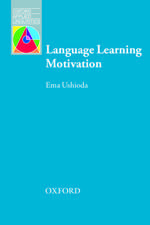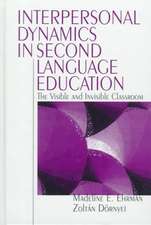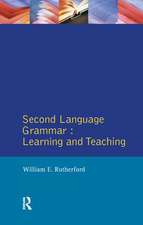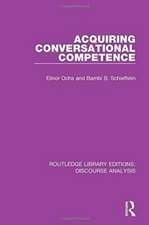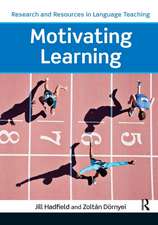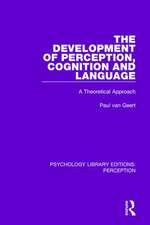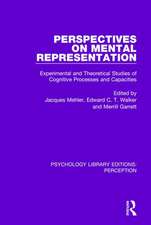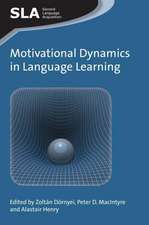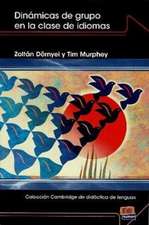Teaching and Researching: Motivation: Applied Linguistics in Action
Autor Zoltán Dörnyei, Ema Ushiodaen Limba Engleză Hardback – 27 apr 2015
Key new features and material:
· A brand new chapter on current socio-dynamic and complex systems perspectives
· New approaches to motivating students based on the L2 Motivational Self System
· Illustrative summaries of qualitative and mixed methods studies
· Samples of new self-related motivation measures
Providing a clear and comprehensive theory-driven account of motivation, Teaching and Researching Motivation examines how theoretical insights can be used in everyday teaching practice, and offers practical tips. The final section provides a range of useful resources, including relevant websites, key reference works and tried and tested example questionnaires. Written in an accessible style and illustrated with concrete examples, it is an invaluable resource for teachers and researchers alike.
| Toate formatele și edițiile | Preț | Express |
|---|---|---|
| Paperback (1) | 297.06 lei 22-36 zile | +25.08 lei 5-11 zile |
| Taylor & Francis – 29 iul 2010 | 297.06 lei 22-36 zile | +25.08 lei 5-11 zile |
| Hardback (1) | 1005.80 lei 43-57 zile | |
| Taylor & Francis – 27 apr 2015 | 1005.80 lei 43-57 zile |
Preț: 1005.80 lei
Preț vechi: 1226.58 lei
-18% Nou
Puncte Express: 1509
Preț estimativ în valută:
192.45€ • 201.48$ • 159.25£
192.45€ • 201.48$ • 159.25£
Carte tipărită la comandă
Livrare economică 07-21 aprilie
Preluare comenzi: 021 569.72.76
Specificații
ISBN-13: 9781138835559
ISBN-10: 1138835552
Pagini: 344
Dimensiuni: 156 x 234 mm
Greutate: 0.61 kg
Ediția:Revised
Editura: Taylor & Francis
Colecția Routledge
Seria Applied Linguistics in Action
Locul publicării:Oxford, United Kingdom
ISBN-10: 1138835552
Pagini: 344
Dimensiuni: 156 x 234 mm
Greutate: 0.61 kg
Ediția:Revised
Editura: Taylor & Francis
Colecția Routledge
Seria Applied Linguistics in Action
Locul publicării:Oxford, United Kingdom
Cuprins
General Editors’ Preface
Acknowledgements
Introduction to the Second Edition
Section I: What is motivation?
1 Exploring motivation: Changing perspectives
1.1 The complexity of motivation
1.2 The challenge of reduction versus comprehensiveness
1.3 Moving beyond linear models of motivation
2 Theories of motivation in psychology
2.1 Key cognitive theories and constructs of motivation
2.2 Motivation and context
3 Motivation to learn a foreign/second language: a historical overview
3.1 The social psychological period
3.2 The cognitive-situated period
3.3 The process-oriented period
3.4 From process-oriented to socio-dynamic perspectives
4 Motivation to learn another language: current socio-dynamic perspectives
4.1 A person-in-context relational view of motivation
4.2 The L2 Motivational Self System
4.3 Motivation from a complex dynamic systems perspective
Section II: Motivation and language teaching
5 Motivation in practice: strategies and approaches
5.1 From theory and research to classroom practice
5.2 A framework for motivational strategies
5.3 Generating and sustaining a vision for language learning
5.4 Developing a motivation-sensitive teaching approach
6 Motivation in context: demotivating influences
6.1 ‘Demotivation’ versus ‘motivation’
6.2 Research on demotivation in instructional communication studies
6.3 Findings in L2 motivation research
6.4 Critical factors in the broader sociocultural context
6.5 Concluding remarks on demotivation
7 Teacher motivation
7.1 Conceptualising the ‘motivation to teach’
7.2 The motivation of L2 teachers
7.3 The relationship between teacher motivation and student motivation
Section III: Researching motivation
8 Making motivation a researchable concept
8.1 Inherent problems in motivation research
8.2 Deciding on the particular aspect of motivation to focus on
8.3 Selecting the criterion/dependent variable
8.4 Selecting the method of inquiry
9 Main types and methods of motivation research
9.1 Focus on groups of learners: Quantitative studies
9.2 Focus on individual learners: Qualitative studies
9.3 Mixing methodologies
9.4 Adopting a complex dynamic systems approach
Section IV: Resources and further information
10 The locus of motivation research: Linkages to other topics and disciplines
10.1 Language-learning motivation and related disciplines in the social sciences
10.2 The place of motivation research in applied linguistics
11 Sources and resources
11.1 Relevant journals and magazines
11.2 Databases, citation indexes, Internet resources and discussion groups
11.3 Sample tests and measurement instruments
References
Author index
Subject index
Acknowledgements
Introduction to the Second Edition
Section I: What is motivation?
1 Exploring motivation: Changing perspectives
1.1 The complexity of motivation
1.2 The challenge of reduction versus comprehensiveness
1.3 Moving beyond linear models of motivation
2 Theories of motivation in psychology
2.1 Key cognitive theories and constructs of motivation
2.2 Motivation and context
3 Motivation to learn a foreign/second language: a historical overview
3.1 The social psychological period
3.2 The cognitive-situated period
3.3 The process-oriented period
3.4 From process-oriented to socio-dynamic perspectives
4 Motivation to learn another language: current socio-dynamic perspectives
4.1 A person-in-context relational view of motivation
4.2 The L2 Motivational Self System
4.3 Motivation from a complex dynamic systems perspective
Section II: Motivation and language teaching
5 Motivation in practice: strategies and approaches
5.1 From theory and research to classroom practice
5.2 A framework for motivational strategies
5.3 Generating and sustaining a vision for language learning
5.4 Developing a motivation-sensitive teaching approach
6 Motivation in context: demotivating influences
6.1 ‘Demotivation’ versus ‘motivation’
6.2 Research on demotivation in instructional communication studies
6.3 Findings in L2 motivation research
6.4 Critical factors in the broader sociocultural context
6.5 Concluding remarks on demotivation
7 Teacher motivation
7.1 Conceptualising the ‘motivation to teach’
7.2 The motivation of L2 teachers
7.3 The relationship between teacher motivation and student motivation
Section III: Researching motivation
8 Making motivation a researchable concept
8.1 Inherent problems in motivation research
8.2 Deciding on the particular aspect of motivation to focus on
8.3 Selecting the criterion/dependent variable
8.4 Selecting the method of inquiry
9 Main types and methods of motivation research
9.1 Focus on groups of learners: Quantitative studies
9.2 Focus on individual learners: Qualitative studies
9.3 Mixing methodologies
9.4 Adopting a complex dynamic systems approach
Section IV: Resources and further information
10 The locus of motivation research: Linkages to other topics and disciplines
10.1 Language-learning motivation and related disciplines in the social sciences
10.2 The place of motivation research in applied linguistics
11 Sources and resources
11.1 Relevant journals and magazines
11.2 Databases, citation indexes, Internet resources and discussion groups
11.3 Sample tests and measurement instruments
References
Author index
Subject index
Notă biografică
Zoltán Dörnyei is Professor of Psycholinguistics in the School of English Studies, University of Nottingham. He is author of a number of books including Research Methods in Applied Linguistics and The Psychology of Second Language Acquisition. He has also co-edited Motivation, Language Identity and the L2 Self with Ema Ushioda.
Ema Ushioda is an Associate Professor in ELT and Applied Linguistics at the Centre for Applied Linguistics, University of Warwick. Her publications include Learner Autonomy 5: The Role of Motivation and Learner Autonomy in the Foreign Language Classroom: Teacher, Learner, Curriculum and Assessment (with David Little and Jennifer Ridley).
Ema Ushioda is an Associate Professor in ELT and Applied Linguistics at the Centre for Applied Linguistics, University of Warwick. Her publications include Learner Autonomy 5: The Role of Motivation and Learner Autonomy in the Foreign Language Classroom: Teacher, Learner, Curriculum and Assessment (with David Little and Jennifer Ridley).
Descriere
Learner motivation is critical to success. This book combines Dornyei's own well-known theory of language motivation, with a comprehensive review of both the psychological and the second language literature. Teaching and Researching: Motivation gives guidance on useful resources, including relevant websites, lists of key reference works and over 150 actual questionnaire items that have formed the basis of the author's extensive field research.














